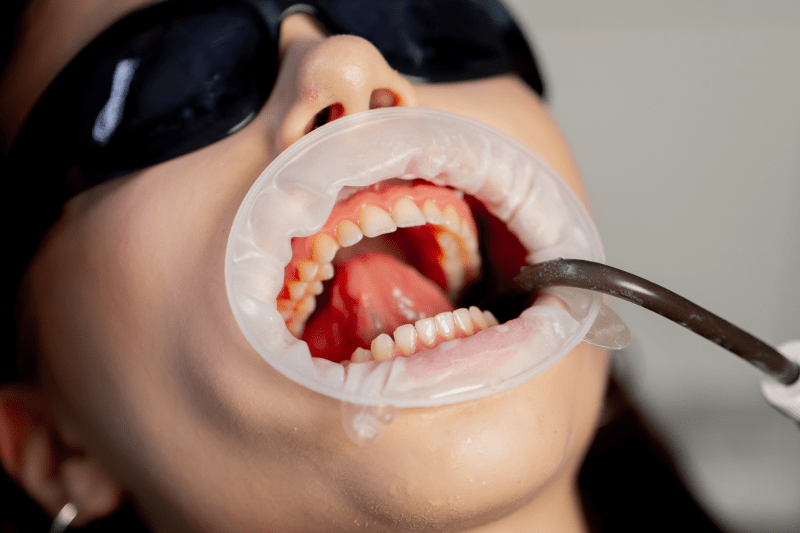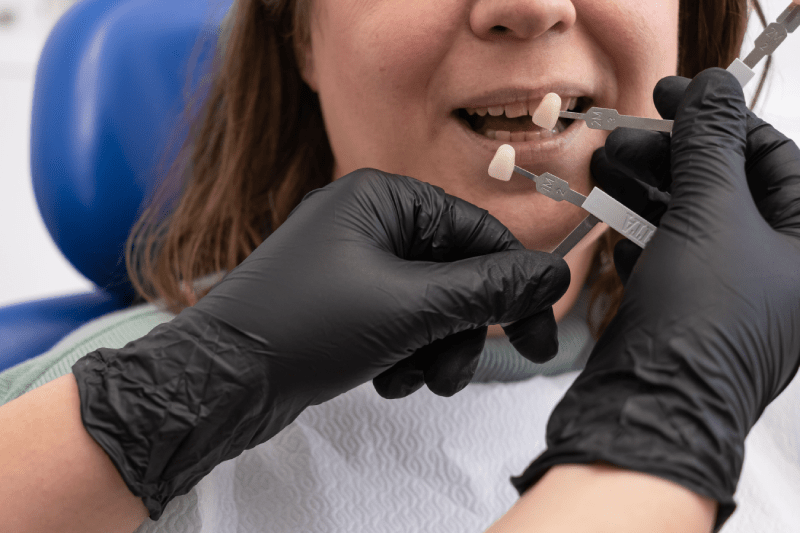What Are The Biggest Advantages Of Dental Bridges?
One of the biggest advantages of dental bridges is that they quickly restore chewing function and aesthetic appearance by replacing missing teeth. They eliminate the difficulty of chewing caused by missing teeth, which helps with better food grinding and aids the digestive system. Additionally, by filling the gaps, they prevent other teeth from shifting and prevent the deterioration of the oral structure. Offering a permanent solution with a short treatment period and being more cost-effective than implant treatment are also significant advantages.
What Are The Most Significant Disadvantages Of Dental Bridge Treatment?
The most significant disadvantage of dental bridge treatment is that it requires the neighboring healthy teeth to be trimmed and reduced for support. This is an irreversible process and can harm healthy teeth. Another disadvantage is the difficulty of cleaning the gums and teeth under the bridge. This can lead to plaque buildup and potentially cavities or gum inflammation over time. Therefore, it requires a regular and meticulous oral hygiene routine.
Are Dental Bridges Aesthetically Successful?
Thanks to modern dentistry, dental bridges provide highly successful aesthetic results. Materials like zirconium and full porcelain, in particular, reflect light just like natural teeth, providing perfect color and brightness harmony. Dentists custom-design the shape, size, and color of the bridge to be in complete harmony with the patient’s natural teeth. This ensures that the bridges are not noticeable in the mouth and give the patient a natural and attractive smile.
Is There A Difference Between A Dental Bridge And Natural Teeth?
A properly made dental bridge of high-quality materials has very little aesthetic and functional difference from natural teeth. Patients can comfortably perform daily functions like chewing and speaking just as they would with their normal teeth. However, a bridge has a more fixed structure than a natural tooth because it does not have a root embedded in the bone. This may cause a slight difference in sensation at first, but patients quickly get used to it.
Is Dental Bridge Treatment Painful?
Dental bridge treatment is generally a painless procedure because local anesthesia is applied during the process. This prevents you from feeling any pain while the abutment teeth are being prepared and the bridge is being placed. There might be some mild sensitivity or pain after the procedure, but this usually subsides on its own within a few days. Your dentist can recommend suitable painkillers to minimize any potential discomfort during this period.
How Do Dental Bridges Affect Chewing Function?
Dental bridges completely restore the loss of chewing function caused by a missing tooth. Missing teeth can cause the chewing force to be distributed unevenly among the other teeth. This can lead to excessive strain and even jaw joint problems. A dental bridge distributes chewing pressure evenly, allowing all teeth to work in harmony, making chewing more efficient and comfortable.
How Do Dental Bridges Affect Oral Health?
Dental bridges can affect oral health both positively and negatively. The positive effect is that they prevent other teeth from shifting into the gap, thereby preserving the dental structure and improving chewing function. The negative effect is that if the areas under the bridge are not cleaned properly, it can create a breeding ground for plaque buildup and cavities. Therefore, a regular and correct oral hygiene routine is critical for the bridge to positively affect oral health.
Is A Dental Bridge An Alternative To Implant Treatment?
Yes, a dental bridge is an alternative to implant treatment. It is an ideal solution, especially for patients who do not have sufficient bone structure for implant treatment or who want to avoid a surgical procedure. Bridge treatment is completed in a shorter time than implants and is generally more cost-effective. However, while a bridge requires trimming healthy neighboring teeth, implants function independently. Therefore, you should discuss both options with your dentist to choose the one that is most suitable for you.
What Is The Lifespan Of A Dental Bridge?
The lifespan of a dental bridge varies depending on the materials used, oral hygiene, and personal habits. On average, a dental bridge can last between 5 and 15 years. With a high-quality material, proper application, and regular oral care, this period can extend up to 20 years. To prolong the life of the bridge, regular brushing, flossing, and dental check-ups are of great importance.
What Shortens The Lifespan Of A Dental Bridge?
The most significant factors that shorten the lifespan of a dental bridge include poor oral hygiene, teeth grinding (bruxism) habits, and smoking. Insufficient oral hygiene can lead to cavities and gum disease in the abutment teeth under the bridge. Teeth grinding can apply excessive force to the bridge, causing cracks or fractures. Smoking can damage gum health, leading to the failure of the bridge.
Am I A Suitable Candidate For A Dental Bridge?
Whether you are a suitable candidate for a dental bridge is determined by a detailed examination by your dentist. Generally, you need to have healthy and strong abutment teeth on both sides of the missing tooth gap. If your abutment teeth are weak or have serious gum disease, bridge treatment may not be suitable. Your dentist will evaluate your oral structure to help you make the right decision.
What Are The Risks Associated With Dental Bridges?
There are some risks associated with dental bridge treatment. One of the biggest risks is the damage and eventual decay of the teeth that support the bridge due to trimming. Additionally, there is a risk of bacteria buildup and gum inflammation in the area under the bridge. A bad bite or a poorly made bridge can cause pain while chewing or problems with the jaw joint. It is important to choose an experienced dentist and not neglect regular check-ups to minimize these risks.
How Long Does Dental Bridge Treatment Take?
Dental bridge treatment is usually completed in two or three appointments. In the first appointment, the abutment teeth are prepared and an impression is taken, which can take about an hour. In the second appointment, the temporary bridge prepared in the lab is placed, and a few weeks later, the permanent bridge is placed. The entire process can take several weeks, depending on the fabrication time of the bridge and the appointment intervals.

What Determines The Price Of A Dental Bridge?
The price of a dental bridge varies depending on the type of material used, the number of missing teeth, any additional treatment needs, and the dentist’s experience. More durable and aesthetic materials like zirconium are more expensive than porcelain-fused-to-metal bridges. Additionally, if extra procedures like root canal treatment are needed for the abutment teeth, the cost may increase. A detailed examination is necessary to get the most accurate price.
Do Dental Bridges Damage Other Teeth?
Dental bridges can damage other teeth if not applied correctly. If the bridge is not strong enough for the abutment teeth, it can lead to overloading of these teeth. Additionally, gaps that form at the edges of the bridge can lead to plaque buildup and cavities, damaging the abutment teeth. Therefore, it is vital that the bridge fits perfectly and is monitored with regular check-ups.
Do Dental Bridges Affect Teeth Grinding Habits?
Dental bridges can pose a risk for patients with a teeth grinding (bruxism) habit. Bruxism can apply excessive force to the bridge, causing cracks, fractures, and wear. Your dentist will recommend using a night guard to protect the bridge if you have this habit. A night guard minimizes the damage that bruxism can cause to the bridge and other teeth.
Is Dental Bridge Care Difficult?
Dental bridge care requires a little more diligence than normal dental care. Special tools (bridge floss, interdental brush, or oral irrigator) are needed to clean the gaps under the bridge. When these areas are not cleaned sufficiently, problems like bacteria buildup and bad breath can occur. However, with the right tools and a regular routine, bridge care can be done easily.
How Is A Dental Bridge Cleaned?
A dental bridge is cleaned with regular brushing and flossing. A special floss called “super floss” or a tool called a “floss threader” is used to clean the areas under the bridge. These tools allow the floss to pass under the bridge. An oral irrigator is also a great tool for effectively cleaning under the bridge.
Is A Dental Bridge Removable?
A dental bridge is a permanent restoration and is not removable. It is cemented to the abutment teeth with a special adhesive. However, if a problem occurs with the bridge (such as a fracture, crack, or looseness), your dentist can carefully remove the bridge with special tools and replace it with a new one. Trying to remove the bridge yourself can damage the abutment teeth.
Can Food Get Trapped Under A Dental Bridge?
Yes, if the dental bridge is not seated perfectly or if there is a sufficient gap under the bridge, food particles can get trapped. This makes oral hygiene difficult and can lead to bad breath, bacteria buildup, and cavities. Therefore, if you feel that food is getting trapped under your bridge, it is important to see your dentist to have the bridge’s fit checked.
Do Dental Bridges Cause Bad Breath?
A dental bridge can cause bad breath if it is not cleaned properly. Food particles and bacterial plaque that accumulate under the bridge can produce gases that lead to bad odor. To prevent this, you should regularly brush your bridge and abutment teeth and use special cleaning tools to clean the area under the bridge.
What Should Be Done If A Dental Bridge Cracks Or Breaks?
If you notice a crack or fracture in your dental bridge, you should contact your dentist immediately. While small cracks can sometimes be repaired, large fractures usually require the bridge to be completely replaced. Continuing to use a broken bridge can harm the abutment teeth and lead to oral health problems.
Do Dental Bridges Cause Allergic Reactions?
Dental bridges can, albeit rarely, cause allergic reactions. This usually stems from allergies to certain metals (e.g., nickel) used in porcelain-fused-to-metal bridges. If you have a known metal allergy, you should inform your dentist. Metal-free materials like zirconium or full porcelain eliminate the risk of an allergic reaction.
Do Dental Bridges Change With Age?
Yes, a dental bridge can change with age. Over time, gums can recede, causing the gap under the bridge to widen. Additionally, abutment teeth may wear down or weaken due to aging. These changes can disrupt the bridge’s fit and may require its replacement. Regular dental check-ups ensure that these changes are noticed early.
Is It Difficult To Eat With A Dental Bridge?
Eating with a dental bridge is easier and more comfortable compared to the difficulties you faced with missing teeth. The bridge restores chewing function. While there may be a slight adjustment period at the beginning, patients quickly get used to their bridges and can comfortably consume normal foods. However, avoiding very hard or sticky foods extends the life of the bridge.
Do Dental Bridges Cause Gum Recession?
Dental bridges can cause gum recession if they are not made correctly or are not well-cared for. Plaque buildup at the edges of the bridge can lead to gum inflammation and, as a result, gum recession. Gum recession exposes the root surfaces of the teeth under the bridge, increasing sensitivity and the risk of cavities. Therefore, regular care and hygiene are very important.
Do Dental Bridges Prevent Other Teeth From Shifting?
Yes, a dental bridge effectively prevents other teeth from shifting into the gap caused by the missing tooth. When teeth are not in contact with each other, they will eventually move into the gap. This can lead to misalignments in the dental arch, chewing problems, and aesthetic concerns. A dental bridge stops this process, preserving the natural alignment of your teeth.
When Can I Eat After Dental Bridge Treatment?
After a temporary bridge is placed, you can eat normally, but it is recommended to avoid very hard or sticky foods. After the permanent bridge is placed, you can usually return to your normal diet within a few hours. Your dentist will give you detailed information on when you can eat and what to pay attention to.
Do Dental Bridges Correct Speech?
Dental bridges can help correct speech impediments caused by missing teeth. The absence of front teeth, in particular, makes the proper pronunciation of some sounds (like s and z) difficult. A dental bridge fills these gaps, allowing the tongue to be in the correct position and improving the clarity of speech.
Do Dental Bridges Affect Facial Structure?
Yes, dental bridges positively affect facial structure. Missing teeth can, over time, cause the jawbone to erode and the facial structure to sink. A dental bridge fills the missing tooth gap, supports the jawbone, and helps maintain the tone of the facial muscles. This provides a more youthful and full facial appearance.
What Type Of Teeth Are Prepared For A Dental Bridge?
For a dental bridge, the healthy and strong teeth located immediately next to the missing tooth gap are prepared. These teeth are called “abutment” or support teeth. The dentist minimally reduces the surface of these teeth to allow the bridge to fit perfectly over them. This process ensures that the bridge is secure and stable.

Are Dental Bridges Covered By Insurance?
Whether a dental bridge is covered by insurance depends on your specific insurance plan and policy. Some insurance companies may cover a portion of the dental bridge cost, while others may not cover it at all. It is important to contact your insurance company before starting treatment to get information about your coverage.
Is Getting A Dental Bridge A Luxury Or A Necessity?
Getting a dental bridge is not just an aesthetic luxury but also a functional necessity. It contributes to your overall health by preventing problems like chewing difficulty, shifting teeth, and changes in jaw structure caused by missing teeth. Therefore, it should be considered both an aesthetic and a functional need.
What Does The Price Of A Dental Bridge Consist Of?
The price of a dental bridge consists of many factors, such as the type of material used (zirconium, porcelain), the number of missing teeth the bridge will support, laboratory costs, and the dentist’s experience. The treatment plan and, consequently, the cost may differ for each patient.
Why Should I Choose Cure Holiday?
When making an important decision like getting a dental bridge, it is essential to work with a trustworthy and experienced partner. Cure Holiday works with expert dentists and modern clinics that provide services at international standards. With personalized treatment plans, transparent pricing, and professional support from start to finish, Cure Holiday strives to provide you with the best dental bridge experience.
For more information about dental bridge treatment and to create a personalized plan, you can contact Cure Holiday. We wish you a healthy smile!



